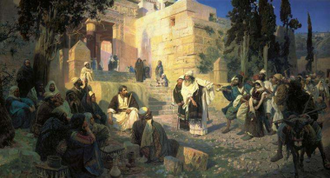Gospel in Art: Let him who is without sin be the first to throw a stone

Christ and the Woman Taken in Adultery painted by Vasily Polenov, 1888. Oil on canvas. © The Russian Museum, St Petersburg, Russia
Source: Christian Art
Gospel of 6 April 2025
John 8:1-11
At that time: Jesus went to the Mount of Olives. Early in the morning he came again to the temple. All the people came to him, and he sat down and taught them. The scribes and the Pharisees brought a woman who had been caught in adultery, and placing her in the midst they said to him, 'Teacher, this woman has been caught in the act of adultery. Now in the Law, Moses commanded us to stone such women. So what do you say?' This they said to test him, that they might have some charge to bring against him. Jesus bent down and wrote with his finger on the ground. And as they continued to ask him, he stood up and said to them, 'Let him who is without sin among you be the first to throw a stone at her.' And once more he bent down and wrote on the ground. But when they heard it, they went away one by one, beginning with the older ones, and Jesus was left alone with the woman standing before him. Jesus stood up and said to her, 'Woman, where are they? Has no one condemned you?' She said, 'No one, Lord.' And Jesus said, 'Neither do I condemn you; go, and from now on sin no more.'
Reflection on the painting
The men who brought the woman to Jesus focused solely on her past failings, while remaining blind to their own past. In contrast, Jesus saw her in an entirely different light: he viewed her whole life, not just her immediate past. He always looks beyond that. He looks at our whole life from the day we were born and takes in account all that happened to us. Our immediate past is one thing, but our whole life is quite another. The men in our Gospel reading fixated on her immediate past and couldn't see beyond that. Furthermore, Jesus also recognised that she had a future, one that her accusers would have denied her.
When the Lord looks at us, He sees the complete picture, not just isolated flaws or mistakes. He does not dwell on a few dark moments but embraces the fullness of our journey. The Lord understands that our lives are not defined by a single chapter but are an unfolding story, still being written, full of the potential for redemption and renewal. That is why the sacrament of Confession is so important, as it puts us back on track.
Vasily Polenov (1844-1927) was a Russian painter associated with the Peredvizhniki (Wanderers) movement, known for his landscapes and historical-religious scenes. A master of light and atmosphere, he sought to bring realism and emotional depth to his work. He was one of Russia's prominent Romantic painters. His travels to the Middle East greatly influenced his biblical paintings, particularly his celebrated series on the life of Christ, including Christ and the Woman Taken in Adultery which we are looking at today. His approach to religious art was innovative, depicting biblical scenes with historical accuracy and a sense of everyday realism rather than grand theatricality.
In our painting we see the dramatic moment where Jesus is confronted by the scribes and Pharisees who have brought a woman accused of adultery before him. At the left-centre of the scene sits Jesus, dressed in a simple robe, calm and composed, radiating an air of wisdom and quiet authority. His expression is serene yet firm, reflecting His divine justice and compassion, looking straight at the woman who seems mortified at what is happening. The setting is an authentically recreated ancient Middle Eastern courtyard, reflecting Polenov's deep research and travels to the Holy Land.
LINKS
Gospel in Art: https://christian.art/
Today's Reflection: https://christian.art/daily-gospel-reading/john-8-1-11-2025/ (with audio)


















